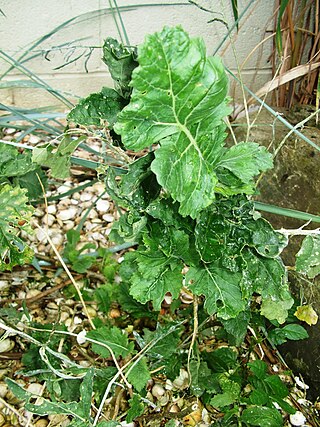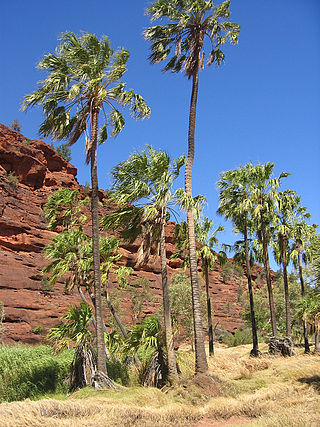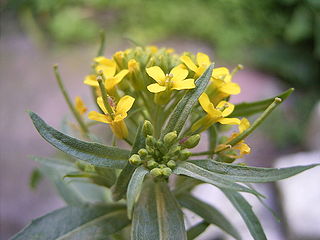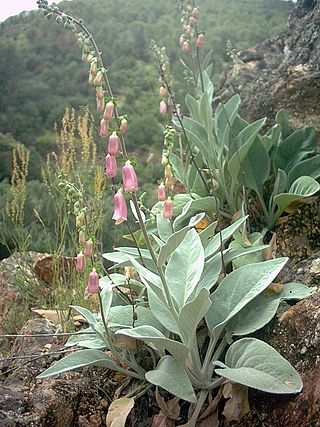
Cabbage, comprising several cultivars of Brassica oleracea, is a leafy green, red (purple), or white biennial plant grown as an annual vegetable crop for its dense-leaved heads. It is descended from the wild cabbage, and belongs to the "cole crops" or brassicas, meaning it is closely related to broccoli and cauliflower ; Brussels sprouts ; and Savoy cabbage.
Manx is an adjective describing things or people related to the Isle of Man:

Chinese cabbage is either of two cultivar groups of leaf vegetables often used in Chinese cuisine: the Pekinensis Group and the Chinensis Group.

Coincya wrightii, known as Lundy cabbage, is a species of primitive brassicoid, endemic to the island of Lundy off the southwestern coast of England, where it is sufficiently isolated to have formed its own species, with its endemic insect pollinators. Coincya wrightii grows natively only on the eastern cliffs and slopes of the island and nowhere else in the world and is a protected species. It reaches up to a metre in height and with its yellow flowers it looks a little similar to oil seed rape. Although it is a member of the cabbage family, it tastes unpleasant – it has been described as "triple-distilled essence of Brussels sprout".

Iberis, commonly called candytuft, is a genus of flowering plants belonging to the family Brassicaceae. It comprises annuals, evergreen perennials and subshrubs native to the Old World. The name "candytuft" is not related to candy, but derives from Candia, the former name of Iraklion on the Island of Crete.

Coincya is a genus of flowering plant that belongs to the family Brassicaceae. Three species of the plant are endemic to the British Isles, these being Coincya wrightii, Coincya cheiranthos (nokkasinapit) and Coincya monensis, which has two subspecies, C. monensis subsp. monensis and C. monensis subsp. recurvata. Another four species are endangered and endemic to the south-central Iberian peninsula.

Coincya monensis subsp. monensis, the Isle of Man cabbage, is a species of plant in the family Brassicaceae that is found in coastal habitats on the west of the island of Great Britain and around the coasts of the Isle of Man.

Livistona mariae, also known as the central Australian or red cabbage palm, is a species of flowering plant in the family Arecaceae.
Antillotyphlops monensis, the Mona worm snake, is a harmless blind snake species is endemic to Mona Island in the West Indies. No subspecies are currently recognized.

Erysimum cheiranthoides, the treacle-mustard,wormseed wallflower, or wormseed mustard is a species of Erysimum native to most of central and northern Europe and northern and central Asia. Like other Erysimum species, E. cheiranthoides accumulates two major classes of defensive chemicals: glucosinolates and cardiac glycosides.

Chilabothrus monensis, also called commonly the Virgin Islands boa in the Virgin Islands, and the Mona Island boa elsewhere, is a species of snake in the family Boidae. The species is native to the West Indies. There are no subspecies.

Coincya monensis is a plant species in the family Brassicaceae. Coincya monensis is native to western Europe and Morocco, but has been introduced in North America.

Turritis is a plant genus in the family Brassicaceae. It contains the following two species:
Coincya cintrana is a flowering plant of the family Brassicaceae. It is a hemicryptophyte plant, and it grows on walls, in steep areas and in rocky slopes. It flowers from April until June.
Psylliodes luridipennis, commonly known as the Lundy cabbage flea beetle or the bronze Lundy cabbage flea beetle, is a species of flea beetle endemic to the island of Lundy, where it lives and feeds upon the endemic Lundy cabbage. Along with the true weevil Ceutorhynchus contractus var. pallipes and an undescribed race of flea beetle Psylliodes napi, it is known only from the Lundy cabbage. The species was first recorded by Thomas Vernon Wollaston in the 1840s, and was named by the Austrian entomologist Franz Kutschera in 1864.

Digitalis mariana is a flowering plant species in the family Plantaginaceae. It is a perennial foxglove with evergreen foliage and rose-red coloured flowers produced in summer. It is native to Portugal and Spain.
Chilabothrus granti, also known commonly as the Virgin Islands boa, is a species of snake in the family Boidae. The species is native to the Caribbean.










